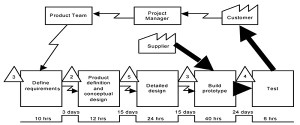
1. Agree on scope and objectives.
- Know the details that this VSM for some product family, Top level / Middle level / Bottom level.
- Must have Value stream manager for each map and make him responsible for implementation too. He should be from Product group, where the VSM will be done.
- You must record in Action plan “Action/Statement/Recommendation” during discussion
- Must follow 80/20 rules through out.
2. Communicate or get a vision from management or Value stream leader, if there is one. It would be nice if it tied in to the company’s Strategic plan, if it is something more than a sales wish list.
3. Define assumption & operator effective time/day for all Value Stream Mapping.
4. Don’t spend most of your time and money documenting the current state (as Is) configuration?
- Just learn enough to find out what works and doesn’t.
- Use it to find and prioritize opportunities.
- Focus on the future state (to be) version(s).
5. Don’t go into infinite detail, until unless required to. Get to the activity level, but not every Data element and work content (this will prompt some questions and Comments – record them).
- Generate action item list as per example, make sure you follow the date.
6. Do a top-down decomposition/organization of the processes first, otherwise every group may come up with its own format, breakdown and version. There may be gaps; contradictions and it may be functionally oriented.
- Make it process and outcome-oriented, rather than functionally oriented.
- Make the Team understand the process breakdown and reorient them to addressing.
- What you definitely do not want is to have departments each go off and do their thing.
- Try using cross-functional teams and experienced Facilitators to help avoid that.
7. VSM’s should emphasize on
- Time element(Cycle time, Queue time, Set up or change over time, shift),
- Metrics,
- Defects/waste, exceptions,
- Responsible or resources, responsibilities (handoffs and unclear Resp. highlighted)
- Applicable rules/policies.
- Each process and sub-process should have a name and objectives, along with applicable metrics (if applicable).
- The future state might include targeted improvements in metrics.
8. People assigned to do VSM are often uncomfortable with inconsistencies, contradictions and gaps detected. Sometimes they fudge them and will even make up stuff to complete them and make them look logical and consistent, even if they are not really so. This is amusing, but dangerous. Make it clear that gaps, inconsistencies and contradictions should be documented as such, in the current state charts, and solved in the future state versions.
9. Make sure that top management is on board with the scope, objectives and approach and that it communicates its expectations clearly to the project team, line management and affected employees.
10. Finally
- The VSM will be just a paper Kaizen, if people do nothing with it.
- How to bring it to life: Make it clear that this is a change management effort for the organization’s future, not a historical chronicle.
- Make it crystal clear that the mission is dramatic process improvement, maybe even reinvention of the company.
- Focus on the best improvement opportunities and achieve some short-term wins to build momentum and excitement.
- Encourage the team to commit to making dramatic improvements. Even if they fall short, it will probably be better than if they hadn’t tried so hard.
- People who just make negative jokes about it and become non-value-added assets should be elbowed aside, or worse.
- Monitor progress, measure the results, follow-up to remedy problems and shortfalls.
11. Seed the teams with “spark plug” types VSM Leader who lead and get things done. Support these teams and help them overcome obstacles, including (especially!) those in human form.
12. Provide some formal training on VSM, if required. This is just too important and new to let people just “wing it.”
13. Keep it Simple, S_____.
[wpdm_tree category=”vsm-templates”]
Risk on VSM:
- Because some facilitator go into Way too much detail, organize the maps poorly or use ineffective Approaches/techniques. Sometimes it appears that they are trying to “milk” the project budget, but often it is done because expectations have been improperly set or they don’t want to leave themselves open to accusations That anything was “left out.” Sometimes they spend man-months to develop Incredibly intricate and beautiful colour Visio charts suitable for display in The Museum of Modern Art. My advice: Do it on brown paper on the walls. Put later versions on fancy computer software, otherwise, you’ll end up blowing a Lot of your budget on charts and endless meetings, instead of paying to map your future.
- Management might not have a plan to effectively create and act upon the VSM effort. Consultants can’t do this in a vacuum, since it requires company Knowledge, participation, support, leadership and implementation effort. While consultants can help with much of this, most of it must be present Internally for ultimate success. Use consultants for knowledge transfer, Coaching and extra resources.
- There may be insufficient competency and resources to do the job.
- Scope, objectives, vision, approach and project management may be lacking.


